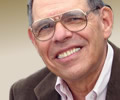Doctor Atomic John Adams’ 2005 opera was broadcast today (Nov 8, 2008) in HD. The opera depicts the first atomic explosion in Los Alamos NM in 1945. The libretto by Peter Sellars is a pastiche (crazy quilt might be more accurate) of material written by the opera’s protagonists, Baudelaire, Muriel Rukeyser, John Donne, excerpts from the Bhagavad Gita, and who knows what else. The result is a very long opera – three and half hours including a single intermission – that lacks dramatic cohesion and strong character delineation.
Using the first atomic bomb as a subject risks pretension and moralizing. Sellars and Adams try to avoid these perils but they can’t help stumbling on them. As momentous as the Trinity test was the reality is that if J Robert Oppenheimer and his colleagues hadn’t introduced atomic weapons to the world’s woes some other J Robert Oppenheimer leading another band of scientists would have. The bomb was in the scientific mix of the 20th century. It was inevitable. No amount of teeth gnashing and hair pulling could forestall the ineluctable bomb. The mind is more deadly than the sword.
Of course, this wouldn’t matter if Adams had written a great opera. You can’t judge a new opera by one hearing so I listened to a recording of the Met’s production of this work several times before attending its screening. Thus, I think I had it in my head before attending this performance. With the exception of Oppenheimer’s aria that concludes the first act “Batter my heart, three person’d God” – Donne’s Holy Sonnet XIV – and some of the orchestral passages the opera is a yawner. I noticed a number of nappers in the audience, especially in the first act. There were no snoozers at the previous HD broadcasts I attended.
The test of any new opera is would you want to see it more than once. Once is enough for Doctor Atomic. The Met has been filling the seats with sharply discounted tickets. Most of Doctor Atomic is recitative. Not only is there no living composer who knows how to write an opera that demands repeated viewing and listening, there’s none who knows how to write recitative. Listen to the recitatives of the great Italians and you encounter invention and interest. Adams like all his contemporaries writes recitatives that whine and go on and on like an endless sine wave – utterly and predictably boring.
In addition to setting off the bomb, there is a second plot involving Oppenheimer’s wife and her Indian maid. It adds little but length to the opera. There’s a “love duet” in the first act which takes place on a bed and ends with Oppenheimer walking out of the room without having done anything but recite a few lines of poetry while his wife throws an object against the wall. This would have been a good spot for a product ad for Viagra. The music for this duet makes no impression. In the second act the maid sings a lullaby (you could only tell it’s a lullaby from its description in the program notes) that sounds like almost everything else in the piece.
The opera concludes with a long countdown to the first atomic blast. This goes on for so long that by the time the blast happens – a flash of light and a computerized scream – that any chance of dramatic release is squandered. There are few lines in Japanese about wanting water and the opera ends not with a bang but a whimper.
The opera’s original staging was by its librettist Peter Sellars. Apparently, Met General Manager Peter Gelb was dissatisfied with this production and commissioned Penny Woolcock to do a new staging. He should have saved his money. Ms Woolcock’s production added little to the performance. There were three rows of boxes at the rear of the stage which at times were overlayed with the periodic table of the elements and at others contained people sometimes in contorted positions. There wasn’t a chiropractor credited in the program though I’m sure at least one was needed. At the end of the opera, the top row of boxes had choristers dressed as Native Americans. I can think of no reason why they were there. Interestingly their headdresses looked more like those of Wagner’s Valkyries than American Indians.
The performance was better than the score. Baritone Gerald Finley has made a career of portraying Oppenheimer since the opera’s premiere. He made the most of the notes that were handed him and was as convincing as possible. That Oppenheimer’s sense of conflict over what he wrought was not well conveyed was more the composer’s than the baritone’s fault. Though the part lies rather high in the baritone range, Finley had no trouble with this tessitura.
Richard Paul Fink was good as Edward Teller though none of the Hungarian physicist’s spookiness was in his portrayal, again not the singer’s doing. Mezzo-soprano Sasha Cooke was attractive and sang well in the superfluous part of Kitty Oppenheimer. Eric Owens was appropriately corpulent as the overweight and sometimes overwrought General Leslie Groves. The whole cast acquitted itself as well as possible with the exception of Meredith Arwady who sang the role of the Indian maid Pasqualita. Her sound was rough and she made little of a part that didn’t have much in it to begin with.
Alan Gilbert, whose reward for losing his job as Music Director of the Santa Fe Opera has been the baton at the New York Philharmonic, conducted with power and intensity. He got everything that was in the score from the Met’s superb orchestra. The most interesting parts of the score were those for orchestra alone. Though they sounded just like most of the orchestral pieces Adams has produced over the last several decades. The chorus was as vocally impressive as the orchestra. In summary, another new opera that bombed.







This is why I read medicine-operascom. Nice posts.